+ Open data
Open data
- Basic information
Basic information
| Entry | Database: PDB / ID: 4gqz | ||||||
|---|---|---|---|---|---|---|---|
| Title | Crystal Structure of S.CueP | ||||||
 Components Components | Putative periplasmic or exported protein | ||||||
 Keywords Keywords | METAL BINDING PROTEIN / CueP / V-shape dimer / Copper_resistance | ||||||
| Function / homology | Immunoglobulin-like - #3700 / Immunoglobulin-like / Sandwich / Mainly Beta / Putative periplasmic or exported protein Function and homology information Function and homology information | ||||||
| Biological species |  Salmonella enterica subsp. enterica serovar Typhimurium (bacteria) Salmonella enterica subsp. enterica serovar Typhimurium (bacteria) | ||||||
| Method |  X-RAY DIFFRACTION / X-RAY DIFFRACTION /  SYNCHROTRON / SYNCHROTRON /  MAD / Resolution: 1.799 Å MAD / Resolution: 1.799 Å | ||||||
 Authors Authors | Ha, N.C. / Yoon, B.Y. | ||||||
 Citation Citation |  Journal: Acta Crystallogr.,Sect.D / Year: 2013 Journal: Acta Crystallogr.,Sect.D / Year: 2013Title: Structure of the periplasmic copper-binding protein CueP from Salmonella enterica serovar Typhimurium Authors: Yoon, B.-Y. / Kim, Y.-H. / Kim, N. / Yun, B.-Y. / Kim, J.-S. / Lee, J.-H. / Cho, H.-S. / Lee, K. / Ha, N.-C. | ||||||
| History |
|
- Structure visualization
Structure visualization
| Structure viewer | Molecule:  Molmil Molmil Jmol/JSmol Jmol/JSmol |
|---|
- Downloads & links
Downloads & links
- Download
Download
| PDBx/mmCIF format |  4gqz.cif.gz 4gqz.cif.gz | 139.3 KB | Display |  PDBx/mmCIF format PDBx/mmCIF format |
|---|---|---|---|---|
| PDB format |  pdb4gqz.ent.gz pdb4gqz.ent.gz | 115.3 KB | Display |  PDB format PDB format |
| PDBx/mmJSON format |  4gqz.json.gz 4gqz.json.gz | Tree view |  PDBx/mmJSON format PDBx/mmJSON format | |
| Others |  Other downloads Other downloads |
-Validation report
| Summary document |  4gqz_validation.pdf.gz 4gqz_validation.pdf.gz | 458.4 KB | Display |  wwPDB validaton report wwPDB validaton report |
|---|---|---|---|---|
| Full document |  4gqz_full_validation.pdf.gz 4gqz_full_validation.pdf.gz | 464 KB | Display | |
| Data in XML |  4gqz_validation.xml.gz 4gqz_validation.xml.gz | 28.8 KB | Display | |
| Data in CIF |  4gqz_validation.cif.gz 4gqz_validation.cif.gz | 42 KB | Display | |
| Arichive directory |  https://data.pdbj.org/pub/pdb/validation_reports/gq/4gqz https://data.pdbj.org/pub/pdb/validation_reports/gq/4gqz ftp://data.pdbj.org/pub/pdb/validation_reports/gq/4gqz ftp://data.pdbj.org/pub/pdb/validation_reports/gq/4gqz | HTTPS FTP |
-Related structure data
| Similar structure data |
|---|
- Links
Links
- Assembly
Assembly
| Deposited unit | 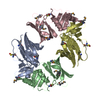
| ||||||||
|---|---|---|---|---|---|---|---|---|---|
| 1 | 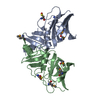
| ||||||||
| 2 | 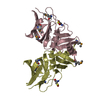
| ||||||||
| Unit cell |
|
- Components
Components
| #1: Protein | Mass: 17928.455 Da / Num. of mol.: 4 / Fragment: UNP residues 21-179 Source method: isolated from a genetically manipulated source Source: (gene. exp.)  Salmonella enterica subsp. enterica serovar Typhimurium (bacteria) Salmonella enterica subsp. enterica serovar Typhimurium (bacteria)Strain: LT2 / Gene: STM3650 / Production host:  #2: Chemical | #3: Water | ChemComp-HOH / | |
|---|
-Experimental details
-Experiment
| Experiment | Method:  X-RAY DIFFRACTION / Number of used crystals: 1 X-RAY DIFFRACTION / Number of used crystals: 1 |
|---|
- Sample preparation
Sample preparation
| Crystal | Density Matthews: 2.38 Å3/Da / Density % sol: 48.28 % Description: THE ENTRY CONTAINS FRIEDEL PAIRS IN F_PLUS/MINUS COLUMNS |
|---|---|
| Crystal grow | Temperature: 287 K / Method: vapor diffusion, hanging drop / pH: 4.6 Details: 0.1M sodium acetate, 2.0M sodium chloride , pH 4.6, VAPOR DIFFUSION, HANGING DROP, temperature 287K |
-Data collection
| Diffraction | Mean temperature: 77 K | ||||||||||||
|---|---|---|---|---|---|---|---|---|---|---|---|---|---|
| Diffraction source | Source:  SYNCHROTRON / Site: SYNCHROTRON / Site:  SPring-8 SPring-8  / Beamline: BL44B2 / Wavelength: 0.9790, 0.9792, 0.9900 / Beamline: BL44B2 / Wavelength: 0.9790, 0.9792, 0.9900 | ||||||||||||
| Detector | Type: ADSC QUANTUM 210 / Detector: CCD / Date: Jun 30, 2011 | ||||||||||||
| Radiation | Monochromator: double mirror / Protocol: MAD / Monochromatic (M) / Laue (L): M / Scattering type: x-ray | ||||||||||||
| Radiation wavelength |
| ||||||||||||
| Reflection | Resolution: 1.799→50 Å / Num. obs: 118693 / % possible obs: 19.7 % / Observed criterion σ(F): 0 / Observed criterion σ(I): 0 / Biso Wilson estimate: 21.89 Å2 | ||||||||||||
| Reflection shell | Resolution: 1.8→1.83 Å / % possible all: 81.1 |
- Processing
Processing
| Software |
| |||||||||||||||||||||||||||||||||||||||||||||||||||||||||||||||||||||||||||||||||||||||||||||||||||||||||||||||||||||||||||||||||||||||||||||||||||||||||||||||||||||||||||||||||||||||||||||
|---|---|---|---|---|---|---|---|---|---|---|---|---|---|---|---|---|---|---|---|---|---|---|---|---|---|---|---|---|---|---|---|---|---|---|---|---|---|---|---|---|---|---|---|---|---|---|---|---|---|---|---|---|---|---|---|---|---|---|---|---|---|---|---|---|---|---|---|---|---|---|---|---|---|---|---|---|---|---|---|---|---|---|---|---|---|---|---|---|---|---|---|---|---|---|---|---|---|---|---|---|---|---|---|---|---|---|---|---|---|---|---|---|---|---|---|---|---|---|---|---|---|---|---|---|---|---|---|---|---|---|---|---|---|---|---|---|---|---|---|---|---|---|---|---|---|---|---|---|---|---|---|---|---|---|---|---|---|---|---|---|---|---|---|---|---|---|---|---|---|---|---|---|---|---|---|---|---|---|---|---|---|---|---|---|---|---|---|---|---|---|
| Refinement | Method to determine structure:  MAD / Resolution: 1.799→40.854 Å / Occupancy max: 1 / Occupancy min: 0.44 / FOM work R set: 0.746 / SU ML: 0.23 / σ(F): 1.45 / Phase error: 31.71 / Stereochemistry target values: ML MAD / Resolution: 1.799→40.854 Å / Occupancy max: 1 / Occupancy min: 0.44 / FOM work R set: 0.746 / SU ML: 0.23 / σ(F): 1.45 / Phase error: 31.71 / Stereochemistry target values: MLDetails: THE ENTRY CONTAINS FRIEDEL PAIRS IN F_PLUS/MINUS COLUMNS
| |||||||||||||||||||||||||||||||||||||||||||||||||||||||||||||||||||||||||||||||||||||||||||||||||||||||||||||||||||||||||||||||||||||||||||||||||||||||||||||||||||||||||||||||||||||||||||||
| Solvent computation | Shrinkage radii: 0.9 Å / VDW probe radii: 1.11 Å / Solvent model: FLAT BULK SOLVENT MODEL | |||||||||||||||||||||||||||||||||||||||||||||||||||||||||||||||||||||||||||||||||||||||||||||||||||||||||||||||||||||||||||||||||||||||||||||||||||||||||||||||||||||||||||||||||||||||||||||
| Displacement parameters | Biso max: 89.66 Å2 / Biso mean: 25.8548 Å2 / Biso min: 12.86 Å2 | |||||||||||||||||||||||||||||||||||||||||||||||||||||||||||||||||||||||||||||||||||||||||||||||||||||||||||||||||||||||||||||||||||||||||||||||||||||||||||||||||||||||||||||||||||||||||||||
| Refinement step | Cycle: LAST / Resolution: 1.799→40.854 Å
| |||||||||||||||||||||||||||||||||||||||||||||||||||||||||||||||||||||||||||||||||||||||||||||||||||||||||||||||||||||||||||||||||||||||||||||||||||||||||||||||||||||||||||||||||||||||||||||
| Refine LS restraints |
| |||||||||||||||||||||||||||||||||||||||||||||||||||||||||||||||||||||||||||||||||||||||||||||||||||||||||||||||||||||||||||||||||||||||||||||||||||||||||||||||||||||||||||||||||||||||||||||
| LS refinement shell | Refine-ID: X-RAY DIFFRACTION / Total num. of bins used: 26
|
 Movie
Movie Controller
Controller



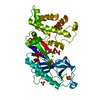
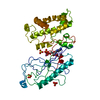
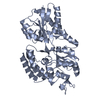

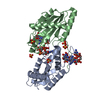
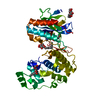
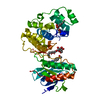
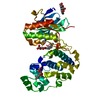
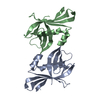
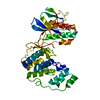
 PDBj
PDBj


